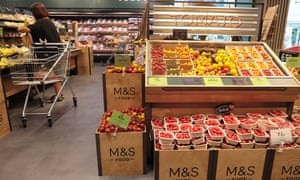[ad_1]
After two years of falling food sales Marks & Spencer is fighting back with larger stores, lower prices and family-sized food packs. And giant, oinking Percy Pigs.
At a freshly revamped store in Hempstead Valley, Kent, the retailers’s new food boss says “even more fun” will be just as important as better food ranges – hence the larger-than-life version of its best-selling novelty sweet in the food aisles.
Stuart Machin says M&S is trying to make headway in the ultra-tight grocery market by loosening up and drawing in more family shoppers. As well as the giant Percy there is a plastic chicken that clucks at the press of a button and a neon sign urging shoppers to “use your loaf”.
“We take our food seriously but we don’t take ourselves too seriously,” he says.

The company is also trying out larger stores where M&S’s full range of more than 6,000 products will be available, with Hempstead one of the first. At present the group has only a dozen sites where all of those items are on offer. Most stock about 2,000 items, which pales besides the 25,000 items per store that major supermarkets offer at typical sites.
Family appeal will be an important part of M&S’s attempt to sell food online through a £750m joint venture with delivery specialist Ocado, which will kick off in September 2020.
If that move is a success, it could hand M&S an additional 1% share of the grocery market according to analysts at stockbroker Liberum. This could put it on a par with – or even above – Waitrose, which is being ousted by Ocado as its food partner.
That would be a huge jump for M&S, which controls just 3.2% of the UK grocery market according to analysts at Nielsen – putting it behind Aldi and Lidl, as well as the major supermarkets including Tesco and Sainsbury’s.
At Hempstead Valley, M&S is pushing its food range by reducing clothing space to double the size of its food hall to nearly 1,580 sq m (17,000 sq ft). It is widening aisles so trollies can be used more easily and adding more fresh produce and fresh bakery goods, as well as additional basics from washing-up liquid to frozen vegetables and even some popular brands including Halo Top ice-cream.
Family-sized packs make up a fifth of the store’s range in Hempstead Valley, compared to about 2% in most M&S food halls.
“We want to be more than just special occasions and a fresh ready meal. Where we have stores which are bigger they actually perform well, there are just too few of them,” Machin says.
The aim is to have a store “with the mind of a supermarket and the soul of a fresh market”, he adds.
At least two additional larger food stores will open before Christmas and some new food sites could be as big as 2,350 sq m. The company is planning a net 50 new standalone food stores over the next three-to-five years, although not all of these will be larger outlets. M&S has more than 1,000 food stores, of which 300 are in full-range sites that also sell clothing.
Machin, a veteran of Sainsbury’s, Tesco, Asda and Coles in Australia who joined M&S in April 2018 in the newly created role of food managing director, was tasked with reinventing M&S’s food business. The company’s chairman, Archie Norman, said the chain was losing ground to competitors because it was too slow to innovate, too expensive and weighed down by excessive waste.
In the past year, M&S has cut back short-term promotions but reduced prices on more than 400 of the most popular lines such as beef mince and bread. A basic loaf of bread is now 75p, down from £1.15, for instance, while a 300g block of Cornish Cove mature cheddar that was £3.85 is now £3 and cherry tomatoes that were £1.00 are now 65p. Concerted effort is being made to modernise an ageing supply chain to reduce waste and speed up bringing in new food ranges.
But can these tweaks really make a difference in persuading families to switch from major supermarkets such as Sainsbury’s or Tesco? Machin says the chain is already several percentage points cheaper than Waitrose, currently the UK’s eighth largest grocer, and has better quality food than its bigger rivals and more focus on the ethical credentials of its suppliers.

Highlighting those ethical standards with sustainability efforts, including cutting back on plastic use, will be part of the fightback. At Hempstead Valley for example, the company is testing cardboard containers for mushrooms and tomatoes and removing plastic bags from bread baked in store. The amount of loose produce on offer has increased 40%.
Having worked in Hempstead Valley’s Sainsbury’s as a schoolboy and returned to manage the store in his 20s as a graduate trainee, Machin is well aware the M&S is surrounded by competitors there, including a large Tesco, a Lidl, an Aldi, a Sainsbury’s and a Morrisons.
In its second week of operation, the revamped store has brought in new shoppers and persuaded them to fill trollies rather than baskets. Machin says there are “green shoots” across the chain as it is increasing the amount of goods sold.
Bryan Roberts, global insights director at research firm TCC Global, says: “No matter what you throw and M&S or Waitrose it doesn’t make you bullet proof to the advances of Aldi and Lidl and the on-going discount threat.” He said M&S’s proud history of innovation and even its reputation for luxury food has been diluted as rivals have caught up. “There is no shortage of places to go for quality convenience foods,” Roberts says.
He says the larger stores could work in selected locations but M&S might find it difficult to find enough sites with car parks and sufficient space to make a major difference. M&S is trying to smile, but how long can it keep it up?
[ad_2]
READ SOURCE


